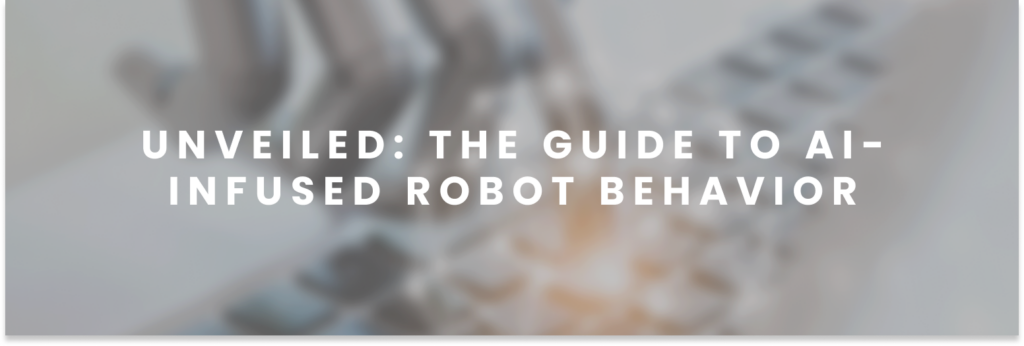Robo-Ethics: 101 Code of Conduct for New AI Bots
The Moral Compass of Robo-ethics
When it comes to artificial intelligence and robotics, the concept of ethics takes center stage as we embark on a journey into the realm of AI-infused robots.
It’s a compelling exploration of the ethical considerations surrounding the development, deployment, and behavior of these advanced machines.
Firstly, let’s lay the foundation by highlighting the rapid advancements in robotics and AI, setting the stage for the ethical dilemmas they bring.
At Effectus Software we are adamant about navigating this intricate terrain through the lens of:
- rights and responsibilities of AI-infused robots
- the decision-making processes
- the potential societal impact of their actions
This is for interested in understanding and contributing to the ongoing dialogue surrounding the moral compass that guides AI-infused robots on their path to daily lives integration.
From Isaac Asimov’s iconic Three Laws of Robotics to the contemporary challenges posed by autonomous machines:
- ethical frameworks
- regulations
- best practices
Join Effectus on a thought-provoking journey through the world ethics where you’ll gain loads of insights.

As artificial intelligence becomes an integral part of robotics, we’re faced with pressing questions about their decision-making processes, ethical responsibilities, and societal impact.
Navigating the Ethical Maze
In today’s technological landscape, the integration of AI into robots has opened a Pandora’s box of ethical considerations.
As robots equipped with AI become increasingly autonomous, understanding the moral frameworks guiding their choices becomes paramount, so:
– Are their decisions sheerly based on algorithms, or do they incorporate ethical principles akin to human judgment? Food for thought.
The Weight of Ethical Responsibilities
Beyond decision-making lies a fundamental question: What ethical responsibilities should we assign to AI-infused robots?
These machines, whether in healthcare, transportation, or customer service, interact with individuals on a daily basis.
As we empower AI-infused robots with greater autonomy and decision-making capabilities, the weight of ethical responsibilities rests squarely on our shoulders, do you agree?
Societal Impact and the Human Connection
These machines have the potential to reshape industries, redefine job roles, and revolutionize how we live and work. Is the new industrial revolution around the corner?
However, their integration into society isn’t without its challenges. Questions about societal impact loom large: potential displacement of workers, data privacy and security.
So revising our values, which will be instilled in these algorithms, becomes of paramount importance.
This video should spring several question in your mind, let’s see if we can frame them. Keep on reading!
Cracking the Code of Conduct
From Asimov to Algorithms
- Science Fiction Roots: it traces its roots back to Asimov’s tales of i-robots and their ethical dilemmas laying the groundwork for the fusion of AI and robotics.
- Realizing Asimov’s Vision: Today, fiction comes as tangible reality. AI-infused robots make autonomous decisions, similar to Asimov’s stories.
- Ethical Frameworks in the Real World: Asimov’s Three Laws of Robotics were fictional and served as an inspiring starting point for real-world discussions on ethical AI.
- Balancing Asimov’s Legacy with Algorithmic Progress: The synergy between these realms offers a glimpse into a future where AI-infused robots operate in harmony with human values and societal norms.
The 3 laws
First Law: “A robot may not harm a human being, or, through inaction, allow a human being to come to harm.” This law places the highest priority on ensuring the safety and well-being of humans. It prohibits robots from taking actions that could cause harm to humans.
Second Law: “A robot must obey the orders given to it by human beings, except where such orders would conflict with the First Law.” The second law emphasizes the importance of following human instructions, as long as doing so does not lead to harm. The safety of humans remains paramount.
Third Law: “A robot must protect its own existence as long as such protection does not conflict with the First or Second Law.” The third law introduces an element of self-preservation. Robots are allowed to take actions to ensure their own survival, but this self-preservation should not override the safety of humans or the obedience to human commands.
Asimov, Isaac. “Three Laws of Robotics”
AI-Infused Robots a Glimpse to Coding
Here you can find some AI-101 code samples to start getting ready for what’s coming. Or else, navigate these future trends!
Let’s get hands on!
Creating AI-infused robots involves writing code that enables these machines to perceive, think, and act intelligently in various environments.
Here are some simplified code examples to illustrate key aspects of AI-infused robot programming:
Sensing and Perception:
# Python code for a simple obstacle detection algorithm using sensors
import random
def detect_obstacle():
sensor_reading = random.randint(0, 1) # Simulated sensor data (0: no obstacle, 1: obstacle)
return sensor_reading
def main():
while True:
if detect_obstacle():
print("Obstacle detected! Stopping robot.")
else:
print("No obstacles ahead. Continuing.")
# Additional code for robot navigation and decision-making here.
if __name__ == "__main__":
main()Decision-Making:
# Python code for a basic decision-making algorithm
def make_decision(sensor_data):
if sensor_data < 0.5:
return "Move forward"
else:
return "Turn left"
def main():
while True:
sensor_data = get_sensor_data() # Get sensor data from robot sensors
decision = make_decision(sensor_data)
execute_decision(decision) # Execute the chosen action
if __name__ == "__main__":
main()Machine Learning for Autonomous Navigation:
# Python code using machine learning (e.g., reinforcement learning) for robot navigation
import numpy as np
from sklearn.ensemble import RandomForestClassifier
# Training data (sensor readings and corresponding actions)
training_data = np.array([[0.2, 0.3, 0.1, "Move forward"],
[0.9, 0.8, 0.5, "Turn left"],
[0.1, 0.2, 0.3, "Move forward"]])
# Define features (sensor readings)
X = training_data[:, :-1]
# Define target (desired actions)
y = training_data[:, -1]
# Train a machine learning model (Random Forest) for decision-making
model = RandomForestClassifier()
model.fit(X, y)
def autonomous_navigation(sensor_data):
action = model.predict([sensor_data])[0]
return action
def main():
while True:
sensor_data = get_sensor_data() # Get sensor data from robot sensors
decision = autonomous_navigation(sensor_data)
execute_decision(decision) # Execute the chosen action
if __name__ == "__main__":
main()
These examples showcase simplified code snippets for AI-infused robots, focusing on aspects like sensing, decision-making, and autonomous navigation. I
For additional components such as computer vision, natural language processing, and reinforcement learning algorithms… keep yourself posted!
Rounding up
We shared how AI has transformed the way we live, presenting new opportunities and also ethical dilemmas.
The programming languages used for AI development include Python, Java, C++, Lisp, Prolog 🇫🇷 and Julia 🇺🇲. We invite you to explore them!
Keep yourself posted and subscribe, we’re utterly convinced that this topic will be in the limelight for quite some time!


Leave a Reply
You must be logged in to post a comment.